World Dream Bank
home -
add a dream -
newest -
art gallery -
sampler -
dreams by
title,
subject,
author,
date,
places,
names
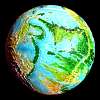

LIBRATIA
by Chris Wayan, 2011-12
for the Wobblies
Libratia basics--map--solar system--tour the night--
More worlds? Planetocopia!
RECIPE FOR A WOBBLY PLANET
Libratia is a world-model exploring the blessings of imperfection. Perhaps 3/4 of the stars in the universe are red dwarfs; worlds orbiting them will outnumber Earths by a wide margin. What are such worlds like? For nearly a century, science fiction writers have portrayed them as mostly grim. To be warm enough, they must orbit close in, and tidal forces get so strong they turn to face their sun--perpetual day on one side, endless night on the other. Such tidelocking is an sf cliché by now--the sunblasted desert and the icy night, with a narrow ring between where life might just be possible.
That picture is false. There are several ways a dim star can have a habitable world.
My model Lyr shows a super-earth orbiting well outside the "Goldilocks zone", kept warm by a dense atmosphere. Little risk of tidelocking if you're big and far from the sun!
Another way: a tidelocked world that's perpetually overcast, like a cooler Venus. A moderately dense atmosphere and thick enough clouds can even out the heat, so all the light side and even possibly the dark side are tolerable; though without sunlight to power it, life on the nightside will be thin.
But even tidelocked little sunhuggers without worldwide clouds aren't as grim as advertised. That fire-and-ice model, with just a narrow ring of Earthlike conditions, requires another perfect ring: a circular orbit. But it's an imperfect universe. This model, Libratia, shows how even a little eccentricity can stimulate a broadening of life (not that you should apply this principle to your life-cycle. Nah.)
What happens to a tidelocked world in an elliptical orbit? It spins steadily, once per orbit--you can't easily speed or slow the spin of a massive rock! But its speed around the sun varies. So as the planet swings near its sun (perihelion), it whips by quickly and angles change fast; the planet's spin lags behind, and the sun doesn't just swell in the sky, it swings east! As the world climbs out to aphelion (furthest point from the sun), the sun shrinks and swings west. This east-west swing is called libration. Below is a chart showing the sideslip at each local hour, or "lor".
(The orbit's shown from "below" Libratia and its sun, not from local north; this makes the loop clockwise, echoing the hours of the day. Elsewhere I'll treat Libratia's orbit as counterclockwise, like Earth's.)
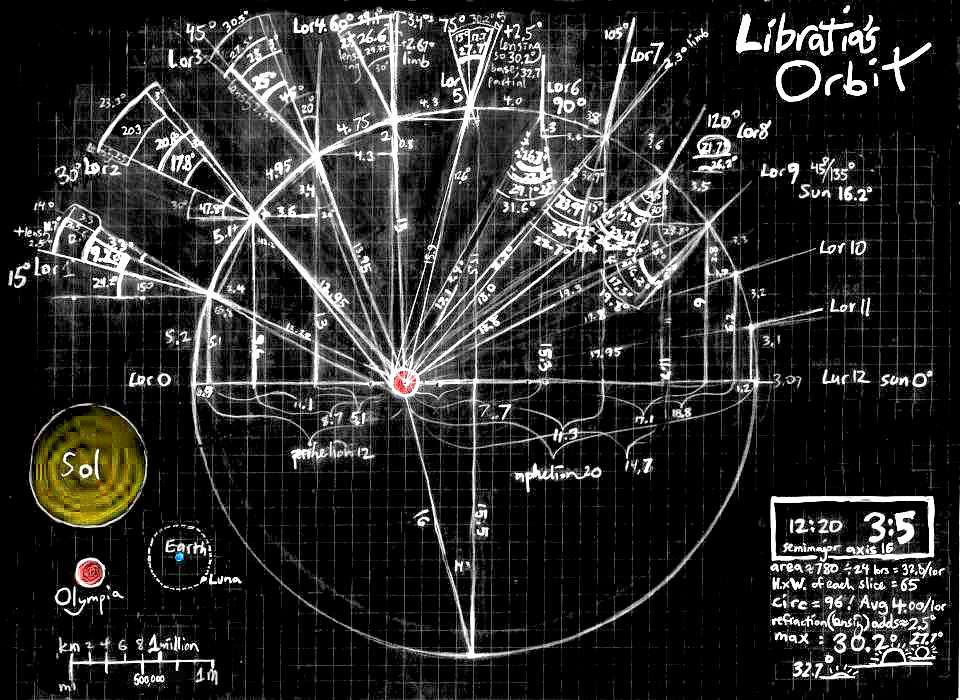 There's a second, simultaneous swing: any axial tilt makes the sun also nod north and south in the sky in an annual cycle: nutation. On Earth, this creates our seasons.
There's a second, simultaneous swing: any axial tilt makes the sun also nod north and south in the sky in an annual cycle: nutation. On Earth, this creates our seasons.
Together these two swings can mean a tidelocked world can have a broad zone indeed with both day and night. Our moon's a modest example: despite a fairly circular orbit and a low axial tilt, we still see, at one time or another, almost 60% of the moon's surface. If we were a tiny sun and Luna a planet at the right distance, about 40% of Luna would see perpetual day, 40% eternal night, and nearly 20% would have a diurnal cycle--sunrises and sunsets.
A third factor shrinks the nightside on planets with dense atmospheres: refraction or lensing. The atmosphere bends sunlight a little around the planet's edge--on Earth, at dawn or dusk, the sun you see is actually about a degree below the horizon. The effect is stronger in dense atmospheres and on high-gravity worlds (dense and thin air-layers are squeezed close).
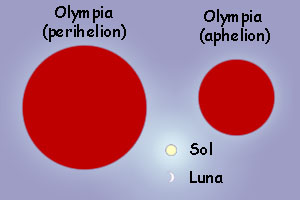
A fourth factor adds a couple of degrees to the area seeing variable sunlight: the apparent width of the sun. Red stars are stingy furnaces and their worlds must huddle very close; such suns look huge in the sky. This adds several degrees to the edge of the dayside, for the sun's center can be well below the horizon, yet you can still stand in sunlight. Mere firelight by our standards, but Libratian plants will feast on it.
To sum up: Libratia has a modestly higher orbital eccentricity than Luna, and a bit more axial tilt. With an east-west swing of about 30°, a north-south swing of about 12°, a solar disc varying from about 4° in orbital winter--8 times as wide (64 times the area) of our sun--and swelling to 6.7° or 13 Sol-widths (169 times the area) at perihelion; and atmospheric lensing that bends sunlight about 2.5° around the limb of the planet. The result?
- 30% of the planet never sees the sun, though it may vary from true night to periodic dusks or predawn light. Near the terminator (the dawn/sunset line) the sunward slopes of high mountains (and Libratia has many) may see regular daylight even though they stand within the nightside. Light islands! And plants can photosynthesize in quite dim light; only 25% of Libratia is too dark for plant life.
The real limit on life won't be light but temperature and soil. Libratia rotates 1/4 as fast as Earth, fast enough so Coriolis forces create somewhat Earthlike strong wind-belts, especially a tropical west-blowing stream and two warm patches near the sunset line at around 30-40° north and south. Warm winds from these make much of Libratia's western dusk-zone ice-free. But much of the night side is icebound: 25% of the planet, over 80% of the night. Of that, most is sea ice, relatively thin; only 7-8% of Libratia's surface is thick glacial ice. The largest chunk is as big as Antarctica, and several more Greenlands dot the nightside. Together they sequester way more ice than Earth does today, but perhaps no more than Earth at the peak of its last Ice Age. And remember, tundra and megafauna flourished near the base of those icecaps. So don't write off the twilight!
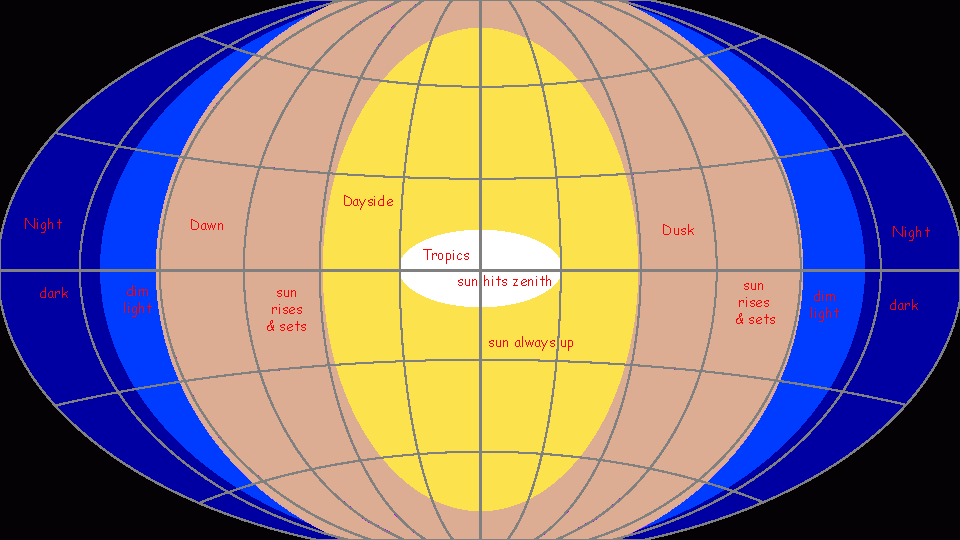
- 33% of Libratia sees perpetual day--but with distinct seasons, for the sun shrinks, grows, and swings across the sky in a 60° arc. Is it really desert? Unlikely; the parts of Earth that get the highest insolation are mostly rainforest. So Libratia's "tropic zone", where the sun passes directly overhead, rarely sees any sun at all! Dense clouds, constant rains. The one-two punch of heat and humidity in the central jungles would likely make even Amazonians wince, but native life will flourish. Desert, phooey.
Not that there are none. The hottest zones on Earth aren't where the sun imparts the most energy, but where cool dry air descends from the stratosphere, dissolving clouds and creating deserts where the sun really gets a chance to heat the surface. This happens in belts around 30° latitude, especially on the western edges of continents. On Libratia, these conditions appear in two broad patches at the same latitude, west of the stormy, humid center--though not all of these patches are desert; seas complicate the picture.
What of the rest of the dayside? Around this broad chevron-shaped hot zone are irregular whorls of warmth and humidity. Not a simple set of concentric rings, any more than Earth is painted in neat climatic stripes. The dayside ranges from steamier than anywhere on Earth to cool-temperate.
- 37% of Libratia sees both day and night! Again, the borders are ragged; near the edges, sunny mountain faces may be lush, while shadowed slopes may be either barren or limited to slow-growing plants harvesting only indirect light--essentially, islands of night. Climates range from subtropical in the equatorial west to sub-arctic in the long eastern arc near the edge of dusk.
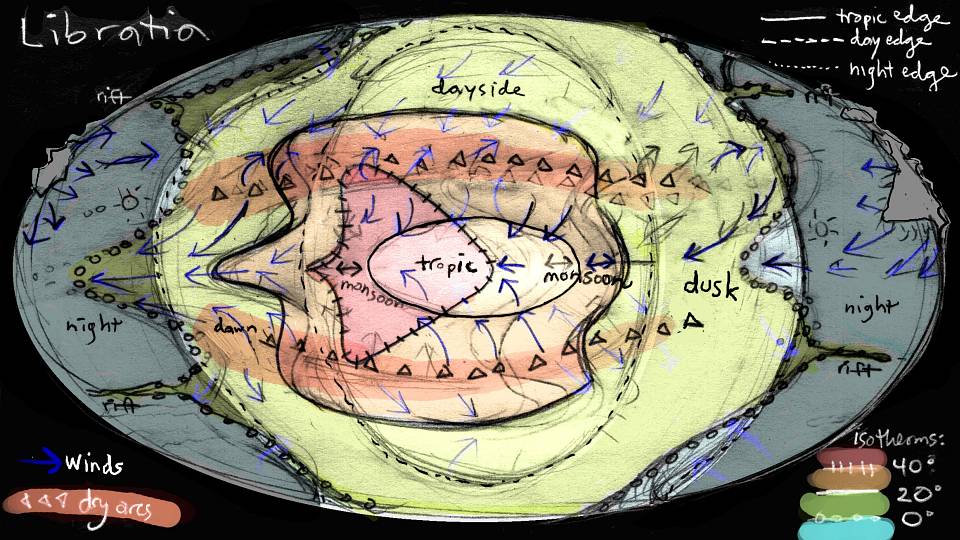
WHY LIBRATIA?
The real question isn't why, but why'd it take me so long? Planetocopia fans have been pestering me for years to build a tidelocked model--after all, these worlds are probably the commonest type in the universe. Partly it's just that it's been done--M.J. Engh's Wheel of the Winds is a fine adventure story describing a Magellanic expedition around a tidelocked world. True, it was heavily overcast worldwide--they never saw the sun, or suspected the existence of other worlds. Was that the only solution?
So I decided to re-examine the classic model that's generally been written off as caught between desert and ice. The more I looked, the more viable a semilocked planet seemed--and interesting, too. Libration made it Earthlike in parts, alien in others.
It was harder to calculate the libration than I expected. Done by hand, folks--and that means a margin of error of a degree or so! Still, I'm pretty confident of the broad picture: done three variants now, with different eccentricities. None were cometary ellipses--all the orbits look round. Yet even modest eccentricity induced big swings. With a perihelion half of aphelion (not my final model, but still looking quite round as orbits go) something like 75-80% of the planet would see sunlight! I picked a more circular orbit in the end, with a mere 70% or so seeing sun--still utterly blasting apart that half-day-half-night cliché. And the "narrow ring" of Earthlike conditions swelled wider than day OR night! How could an artist resist?
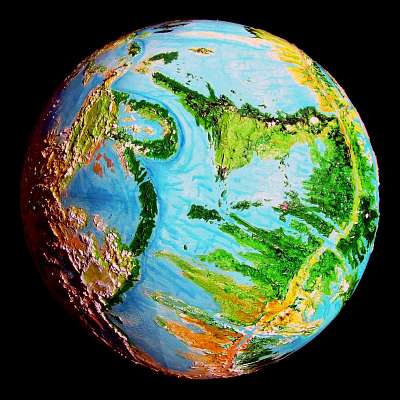
Water? Libratia has less than Earth, and 90% of it is ice. This aspect of tidelocked worlds is what convinced so many thinkers to conclude they'd be desert on the dayside. They forgot two things:
- If 90% of a world's water ends up as ice, so what? If it happened on Earth, the remaining tenth would still create vast oceans. Water spreads out! You just get shallower seas, not deep seas with a tenth the surface area. And it's surface water that generates rain. Planetocopia includes world-models like Pegasia (1/3 our water), Serrana, (1/15th), a terraformed version of Mars (1-2%?) and, most extreme, the desert moon Tharn, with just 0.1%-0.2% of our water. Yet even Tharn STILL has small seas--and abundant life. So Libratia, with a full tenth of Earth's (liquid) water, isn't a dry world at all. It has extensive seas on the dayside--over half the ice-free surface, in fact. Deserts are, if anything, smaller than on Earth, since continents and seas are more broken up.
- Even cold sunless zones aren't guaranteed icecaps:
- You need dry land to build an icecap. Over water, you get sea ice that insulates the sea below; the ice stays thin unless the cold is severe indeed (as on Europa). Most of Libratia's nightside is frozen sea--yards thick, not miles.
- Even on land, ice builds up only to a limit--once the air gets cold and dry, above most blizzards, not enough snow falls to replenish ice creeping slowly outward toward the cap's fringes, to calve into the sea and eventually melt, rejoining the water cycle. Terran icecaps reach equilibrium near 3 km up (a bit under 10,000'). On Libratia, equilibrium is a bit higher up due to the denser air, allowing more high-altitude precipitation; the heart of the nightside icecap tops out near 4000 m (about 13,000'). But the denser air also means it's no colder up there than Antarctica--warmer at times, since Earth's polar caps are isolated by rings of cold winds around latitude 60°; on Libratia, Coriolis forces push warm dayside winds right across the cap, east to west. They lose much of their heat and moisture early in the journey, but the steady air circulation means it never cools enough to freeze out CO2.

STATE OF THE PROJECT
I've just begun Libratia. The solar system has been roughed in; as many as ten planets, several with life of varying complexity and richness. I've charted three orbits for Libratia with different eccentricities: one with a 1:2 ratio between perihelion and aphelion (and after adding modest nutation, lensing and solar-limb spread, nearly 85% of the world sees light!), an orbit with a much gentler 2:3 ratio (65% of the surface sees sun), and a medium one with 3:5, the one I'm using here.
I've roughed in a globe--defined plates, trenches and rifts. The night side's near-done, being simpler, but I'm still building the dayside's landforms--protocontinental plateaus, rifts and fracture zones, mountains and river systems. Only roughed in wind and cloud patterns, rainfall, and the ensuing vegetation. It'll be a couple months minimum before that's done and I can generate regional photos, maps and...
Ground-level tours! Just one, of the nightside, the only zone whose climate is absolutely clear... if cold.
Libratian creatures and cultures? A blank so far. Libratia's evolutionary history hinges on its strange climate, and I haven't firmed that up yet. I do suspect that with the dense atmosphere all but the largest creatures will fly; wings can be much smaller, proportionately. But that's all I know now; the links to geology, evolution, or creatures and cultures pages won't work--not yet. Patience!
THE NUMBERS
-
Sun = a red dwarf we'll call Olympia, as its sunspots and flares have a four-year cycle: one Olympiad!
-
Solar mass: 1/8 Sol's mass. Small, but still 1.5 times the mass of the smallest true stars.
-
Diameter = 0.23 Sol (about 330,000 km, or 210,000 mi). Small, but still 2.5 times Jupiter's width.
-
Density = 10 times Sol's! Tiny stars are too cool to puff up much. Jupiter and Sol have similar densities, only a third of Earth's; but red dwarfs, between them in size, are much denser--indeed, denser than rocky planets! Olympia's lower density than many; it's a bloated, dull, dirty, second- or third-generation star, rich in the metals that created its rocky planet(s). Red dwarfs made of pure hydrogen are more transparent, lose energy through direct radiation, and as a result are smaller and brighter than you'd expect for their mass. And denser still.
-
Visible luminosity = 1/4000 Sol! Visible light is just an eighth to a twelfth of Olympia's full output, though--most is infrared. This has huge consequences. Libratia's dense air lets visible light through and traps the resulting warmth, but it also blocks much of the sun's infrared.
-
Total luminosity = 1/500 Sol, mostly infrared. Libratia's dense air blocks much of it. Instead of greenhousing, the net effect even may be negative. Don't blame the atmosphere! It traps white light efficiently. There just isn't much. Still, some infrared does get through--you can feel Sol's heat on a clear day with your eyes shut, and Olympia puts out even more.
-
Effective planet-heating luminosity = 1/1000 to 1/2000 Sol? Not just uncertain; it varies with the four-year sunspot cycle. Luminosity fluctuates 8-12%; on the planet, that difference is felt as a fluctuation of about 5-10°C (9-18°F).
-
Orbit = elliptical; perihelion 3 million km, aphelion 5 million (.02-.03AU). Purely aside from the libration giving the planet its name, orbital eccentricity heightens seasonal temperature swings--the sun appears to shrink and grow in a 96-hour cycle.
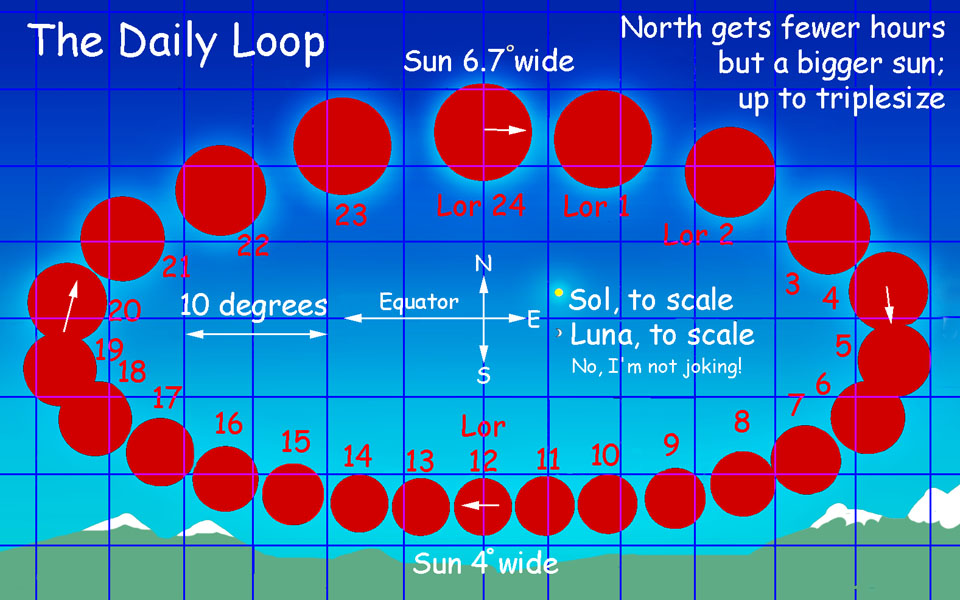
-
Solar year = just 4 Terran days! This is also the length of the diurnal cycle in the regions that have one. By an amazingly convenient coincidence the locals have divided this day/year into 24 time-units called lors, each four hours long. Mnemonic for Terrans: "local hours". Equally convenient: there are 360 Libratian year-days per Olympiad, the four-year solar cycle creating planetwide seasons.
-
Visible sunlight = about 1/4 Earth's, half Mars's. But remember all that infrared...
-
Axial tilt = 12 degrees--just half Earth's. At present the northern hemisphere faces the sun at perigee, the southern at apogee; this creates stronger temperature swings in the north (on Earth the south is harsher). The axis may not precess (wobble in a circle over eons) like Earth's; the current alignment may be tidelocked. The amount of tilt may vary, though. I did say may. With my 19th-century hand-calculations and limited grasp of orbital mechanics, the influences of the sun and Bathos, the nearest thing to a gas giant this system possesses (at 2.9 Earth masses, what can we call it? 'Gassy dwarf' sounds, well, disgusting) are beyond me to calculate. Destabilization or shepherding?
-
Ultraviolet and radiation levels = low ...most of the time! But red dwarfs suffer frequent flares, and Libratia orbits close. The dense atmosphere blocks UV well, but radiation levels cycle from well below Earth's average to far above. Olympia is stable for a red dwarf, but they're still cranky.
-
Sister planets: at least ten, several with life--see Solar System.
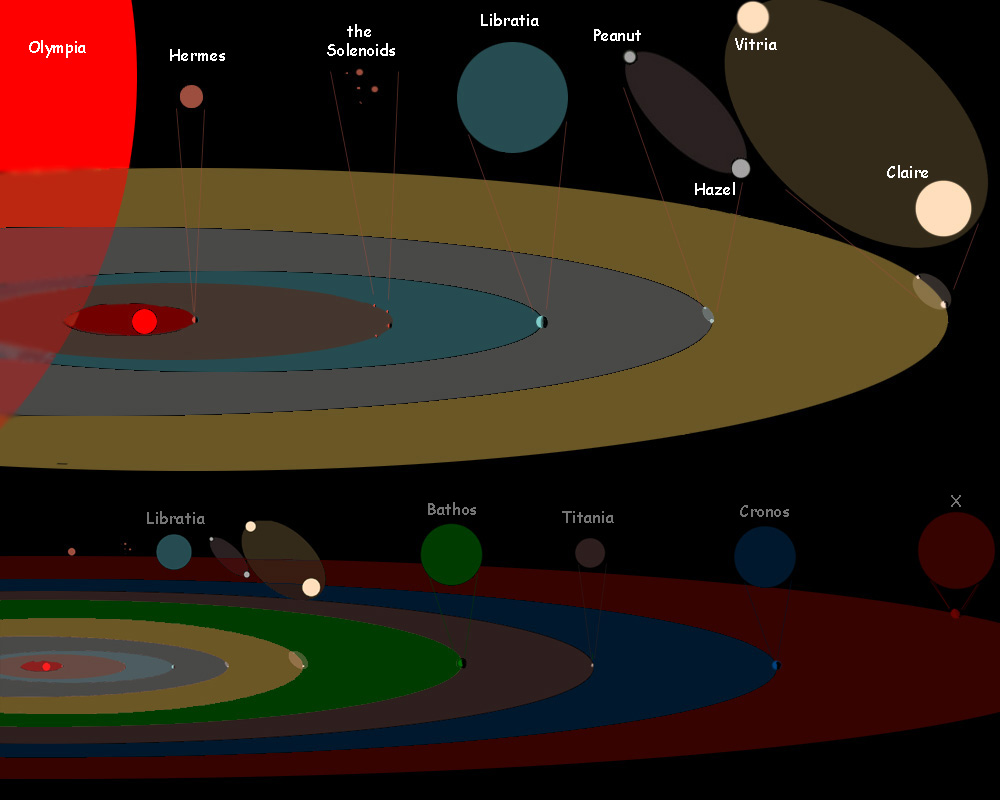
-
Mass = 1.41 Earths; not quite a Super-Earth; a Mildly Pudgy Earth, perhaps.
-
Density = around 4.5 gm/ml, between Venus and Mars; less dense than Earth due to a somewhat smaller iron core.
-
Diameter = about 14,350 km (8923 miles), 12% larger than Earth. Circumference is nearly 45,000 km, or 28,250 mi. A degree is about 125 km (75 mi).
-
Gravity = 0.915 G. You'll weigh 8.5% less. Given Libratia's size you might expect to weigh 12% more, but the extra planetary mass is mostly light mantle rock that puts you further from the pull of the core.
-
Day (and year) = 96 hours.
-
Libratia's surface area = 647 million sq km (250 million sq mi), 25% larger than Earth's.
- Land = 35% of the surface; 226 million sq km (87.5 million square miles). 'Land' here excludes ice. It's about 50% more than Earth's ice-free land!
- Ice = 22%:, 143 million sq km (55 million square miles), or about 9 Antarcticas; nearly equal to all the ice-free land on Earth. But note that much of this is thin sea ice. Thick icecaps cover just 8% of the surface; over twice Earth's ice today, but little more than during our last Ice Age.
- Seas = 43%, 278 million sq km (107.5 million square miles). Excluding ice, 55% of the surface is sea, 45% land. About 85% as big as Earth's seas--quite comparable in area. But not depth! Mostly shallow.
- Dayside = 33%. A fat lens-shape (longer north-south than east-west) bigger than our Pacific. Nearly all habitable, though the deserts and the central typhoon zone (an east-west oval about 80-90° wide and 20-35° high) are hotter than Earth's deserts and rainforests. Local life flourishes, though.
- Dawnside = 38%! Land with both day and night. An uneven ring, narrowing to about 24° around the poles, widening to about 60° at the equator. Mostly habitable; from Amazonian to Alaskan.
- Nightside = 29%. Another broad lens-shape like a cat's eye in the dark. Mostly but not all ice. Fringes habitable; core Antarctic.

- Relief = Earthlike. Low sea levels expose more of this relief, so Libratia looks rugged; almost Martian in spots. From highest peak to deepest trench is 18 vertical km (Earth 20, Venus 14). The gravity's like Earth or Venus; the plasticity of the crust (from heating, mostly tidal friction) is closer to Earth than Venus.
- The highest known peak is Mt XXXX, a shield volcano created by a hotspot, just north of the tropic oval; it's 12 km above sea level (40,000'). Martian? Not at all. Head to (water-cooled) toe, it's just under 13 km tall (43,000'); this isn't really much taller than Hawai'i (11 km/36,000'). Note: I did say known. Exploring, let alone surveying, high mountains on the night side is, understandably, neither safe nor a priority for Libratians. The highest point on the rim of the largest impact crater, Duskring, has been estimated; it's comparable to Everest. Some of the peaks in the Lopi Plateau (near the heart of the nightside) are probably higher.
- A dozen or more Tibetan plateaus, 3-4 km high, dot Libratia. None is as big as Australia--more like Venus's Ishtar or Ovda Highlands. If Libratia had Earth-deep oceans, they'd be small continents; less than 10% land. In Libratia's dense air, many dayside plateaus are habitable, but cast extensive rainshadows. Others ice over.
- Greatest ocean depth is the XXX Trench, about 6 km. Average ocean depth is just 1 km, so the land is continuous and the seas are broken up--the opposite of Earth. Narrow straits do link most of the dayside oceans, but at least two oceans are completely cut off, as are a dozen smaller seas (from Arctic to Caspian in size). One freshwater lake rivals our Mediterranean.
- Cloud cover:
- The dayside varies. A dense oval shades an equatorial belt of warm air bulging up to latitude 20° or so above the subsolar point. The mid-latitude west is mostly sunny, but the east and all the high latitudes up to 60° get quite cloudy. Poles can vary--more clouds than Earth. Unsurprising since they're borderzones, not centers of cold; that's the nightside. The far north, tilting toward the sun near perigee and away at apogee, has strong daily fluctuations--warmer and more storms.
- Twilight zones vary much like Earth's temperate zones with a double rhythm of seasons--orbital seasons just one Earth day long and Olympiad seasons, about a year long.
- The nightside: mostly clear, but with cloudy fringes, and two patchy cloud-belts around 30 south and 60 north, where rift zones create many hot springs and ice-free lakes, and volcanoes vent. Also two huge impact craters near 20° north have ringlakes so deep they're ice-free; these too generate clouds and often are capped in dense fogs.
- Albedo (reflectivity) of sunlit portion: higher than Earth. A flock of heavy clouds huddle directly under the sunniest part. But when you include infrared, not just visible light, insolation is higher, too. Not all the infrared gets through, so it's hard to quantify.
- Air pressure = 3.2 atmospheres. Dense enough so many large animals fly.
- Oxygen = 16%; lower than Earth. But remember the air pressure is triple Earth's; so partial pressure of oxygen is around 2.5 times Earth's. Lungs here are supercharged; another reason so many fly.

- CO2 = 320 ppm; Vulcanism is extensive, and a splendid source of CO2. Smaller oceans to absorb it, but the forests of the torrid zone help. Does any CO2 ever freeze out, in the nightside highlands? Possibly traces; if so, it's in equilibrium; highland glaciers eventually calve into the sea and release it.
- Tectonics? Hyperactive. That huge sun (and it's far denser than our sun, too, as small stars are) means Libratia is under powerful tidal stress--at its closest, up to 169 times the strength of Sol! But three factors make this scary figure misleading:
- Earth's tidal stress is triple what Sol imparts. Don't forget the moon! The gravity-gradient gripping Libratia is 20-55 times Earth's, not 100ish.
- The gradient alone doesn't create tidal stress--it's the movement across it. If Libratia's orbit were circular and axial tilt zero--perfect tidelocking--tidal stress would disappear, despite the sun's deathgrip! Libratia doesn't spin relative to its primary, it just wobbles gently, so Olympia tugs at rocks only diagonally; it can't stretch and squeeze Libratia at right angles, as Luna and Sol both do to Earth twice daily. How this diagonal massage heats the mantle is too complex for me to calculate, but common sense says a 60° swing generates no more than a sixth of a 360° spin); and most of the stress manifests at sharper angles. It may be 1 - cos 30° (about an eighth).
- The tidal massage is one-fourth speed, compared to Earth; Libratia wobbles far slower than Earth spins.
The result? Libratia has a hot mantle, fast plate movements, fractured little plates, many volcanoes and frequent quakes. As the crust's thin and can't bear quite as much weight, the total relief is slightly less than Earth, and looks a bit like Venusian. But only a bit; it's not an Io, white-hot inside from tidal friction and seething with eruptions.
- Tides are high, commonly 3-10 m (10-33'). Highest is about 30 m (100'). Lots of bays and straits are worse than our Bay of Fundy. But that's as bad as it gets--no mile-high tides. Beside the factors above, mitigating tidal stress on Libratia as a whole, two more calm the seas (a bit):
- It's the difference in how much fluid and basin distort that creates a tide. Earth's seas slosh like water in fairly rigid bowls; Because Libratia's crust is fractured into smaller platelets, it's more like a water balloon covered in flakes of cracked paint, seeming solid at a casual glance but moving more like a huge raindrop. The price: quakes are quite common.
- Tides, like waves, are scaled to their parent body of water. Libratia's shallow broken little seas, with no more water than our Caspian or Black Sea, simply lack the fetch for monster tides--except locally, where narrows act as amplifiers.
- Temperature = 10°C? But such a figure is meaningless. The dayside might average 30°C (86°F), the dawnsides 15°C (59°F--quite Earthlike) and the nightside -25°C (-13°F); so is that warmer than Earth or colder? And these regional averages rollercoaster through each day... and Olympiad.
- Habitats = more diverse than Earth's. Most Libratian ecozones have recognizable Terran analogues. But the dayside has hotter, wetter climates than Terran rainforests--call them stormforests--while the edges of the night are adapted to perpetual twilight, with slow-growing well-protected plants and sparse animal life; and the nightside has scattered non-photosynthetic colonies gleaning warmth, minerals and moisture and chemical energy from exposed rift vents--the land equivalent of our mid-ocean vent colonies. Interesting places. If stinky.
-
Biomass = about the same as Earth's! On the dayside, biodensity's about 150% of Earth's.
- Land = 120% of Earth's land biodensity... fewer deserts and more fertile coastal lands, partly offset by the wide ring of sparse subarctic woods, tundra and barrens, much bigger than ours--a Mercator planet! Total land area is larger, so the land biomass is more like 180% of Earth's.
- Sea = 180% of our oceanic biodensity; way more coral reefs feeding on near-constant light. About half the oceans' species, individuals, and biomass live in these reefs! The absolute size of the oceans, in area (and emphatically in volume) is smaller than Earth's, so the total biomass is only 120% of Earth's.
- Ice/Nightside = 0% of Earth's; not enough light to sustain photosynthesis under sea ice, and it never thaws up top: no arctic summer. This drags the planetary average back down to rough parity with Earth.
-
Intelligent species = several? Most fly, since the denser air and lighter gravity both encourage wings. Reefs are very extensive, so the seas may be home to several intelligent marine "mammals" and a tool-using cephalopod. See Peoples of Libratia (only not yet!)
-
Technology = unknown. Will the long, strange diurnal cycle and the somewhat irregular 4-year sunspot/warmth cycle, make civilization on Libratia easier or harder? I do suspect winged sapients will spread their discoveries and technology much faster and more evenly; whatever the natives achieve, all of them will quickly rise to that standard. No stone-age tribes next to nuclear nations, as on Earth.
- Nomenclature: unknown at present.
THE LESSONS OF LIBRATIA
Preliminary conclusion: as we look for life elsewhere, remember: we may love Earth, like Mom, for sentimental reasons, but she's not unique--not even optimal. Just a good-enough mom--and yet we're proof that's all life needs. We don't need to look for other Earths; our search can be much broader than that.
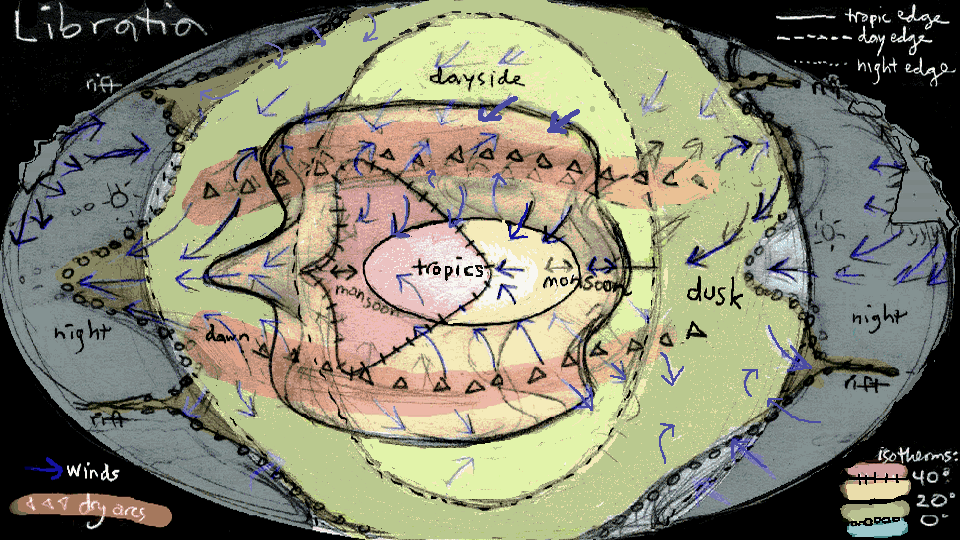 TOURS: italicized names have no pages yet.
TOURS: italicized names have no pages yet.
Nightside:
The Scarline -
Lopi -
Northern Rift -
Southern Rift -
Dawnside:
NorEastia -
MidEastia -
MidSoutheastia -
Southeastia -
WaySoutheastia -
Duskside:
Southdusk Desert -
Equatorial Dusk -
Northduskia 1 -
NorthDuskia 2 -
Northdusk Deserts -
Dayside:
highlands:
Volcano Chain 1 -
Volcano Chain 2 -
Plateau 1 -
Plateau 2 -
Northern Rift -
Central Rift -
Southern Rift -
lowlands:
Arc 1 -
Arc 2 -
Northern Brr -
Southern Brr -
tropics:
Centralia -
Dawny Stormwood
Dusky Stormwood -
Libratia basics--map--solar system--tour the night--
LISTS AND LINKS: More worlds? Planetocopia! - dreams of other worlds - ecology - climate change - evolution - natural disasters - terraforming - sculptures and 3D art -
World Dream Bank homepage - Art gallery - New stuff - Introductory sampler, best dreams, best art - On dreamwork - Books
Indexes: Subject - Author - Date - Names - Places - Art media/styles
Titles: A - B - C - D - E - F - G - H - IJ - KL - M - NO - PQ - R - Sa-Sk - Sl-Sz - T - UV - WXYZ
Email: wdreamb@yahoo.com - Catalog of art, books, CDs - Behind the Curtain: FAQs, bio, site map - Kindred sites